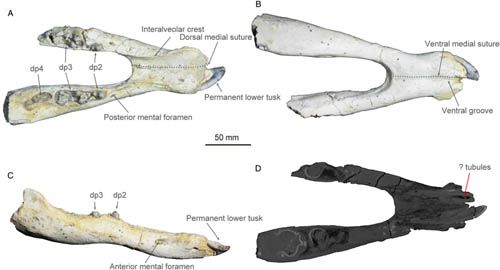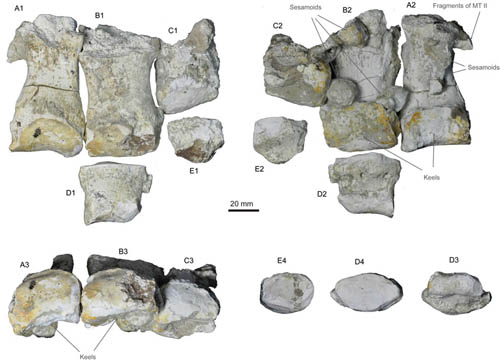| Location: Home > Research > Research Progress |
| New Material from the Miocene of Ningxia (Western China) Reveals Life History of Platybelodon |
|
The middle Miocene Dingjiaergou Fauna in Tongxin County, Ningxia Hui Autonomous Region, western China has yielded 27 taxa from more than 10 families and is approximately equivalent to European Neogene mammal zone (MN) 6. During recent fieldwork, Drs. WANG Shiqi and YE Jie, Institute of Vertebrate Paleontology and Paleoanthropology (IVPP) of the Chinese Academy of Sciences, collected a well-preserved newborn mandible and an incomplete left pes of Platybelodon. As the pes of Platybelodon has not been described before, these new material provides important paleobiological information on Platybelodon. A study published online May 23 in Historical Biology shows that Platybelodon has an early evolution of tooth succession independent from other proboscideans, and owns a light-built body and rapid locomotion relative to other gomphotheres and elephants. In the specimen of newborn mandible, erupted left and right permanent lower tusks (the exposed part of the left tusk is broken), erupted left and right dp2s, erupting left and right dp3s and unerupted right dp4 were preserved. Comparison studies show that the reduction of dp2 in Platybelodon is an independent tendency distinct from that of gomphotheres. Tooth succession in Platybelodon is very specialised, including a tendency to lose the dp2, an early loss of the di2 perhaps at the foetal stage, a tendency to lose the p3 and a tendency to reduce the P4 and the p4. “The relatively derived tooth succession of Platybelodon occurred at a relatively early geological time, thus representing an early evolution of tooth succession independent from other proboscideans”, said study coauthor YE Jie, an emeritus professor of the IVPP. In the incomplete left pes, MT III, MT IV, MT V (all the proximal surfaces of the three bones are broken), proximal phalanx IV and proximal phalanx V are well preserved. The limb bones of elephants are extremely specialised for supporting huge weights. Researchers compared the MT III and MT IV of Platybelodon with other gomphothere taxa and found that the platybelodont pes shows some modifications from that of basal Gomphotherium, with metatarsals IV and III nearly equal in length, metatarsal IV less twisted than metatarsal III, metatarsals IV and III more anteroposteriorly compressed and metatarsals aligned nearly at the same level. These modifications indicate that the standing and moving postures of Platybelodon were distinct from other gomphotheres and true elephants, and Platybelodon should have been more lightly built than other gomphotheres, and may have been adapted for relatively rapid movement, distinct from other gomphotheres. "These findings have important paleobiological significance, adding to our knowledge of the life history of Platybelodon and the diverse adaptations of ancient proboscideans”, said WANG Shiqi, lead author of the study. This work was supported by the National Basic Research Program of China, the Chinese Academy of Sciences and the National Natural Science Foundation of China.  Fig.1 Mandible of a newly born Platybelodon danovi (IVPP V18961). (A) Dorsal view, (B) ventral view, (C) lateral view and (D) tomographic image scanned by a CT scanner. (Image by WANG Shiqi)  Fig.2 Podalic bones of Platybelodon danovi (IVPP V18962). (A) MT III, (B) MT IV, (C) MT V, (D) proximal phalanx IV and (E) proximal phalanx V. X1–X4 are in dorsal, plantar, distal and proximal views, respectively. (Image by WANG Shiqi) |